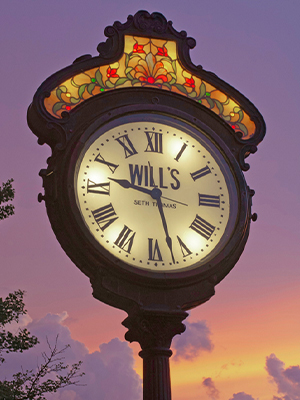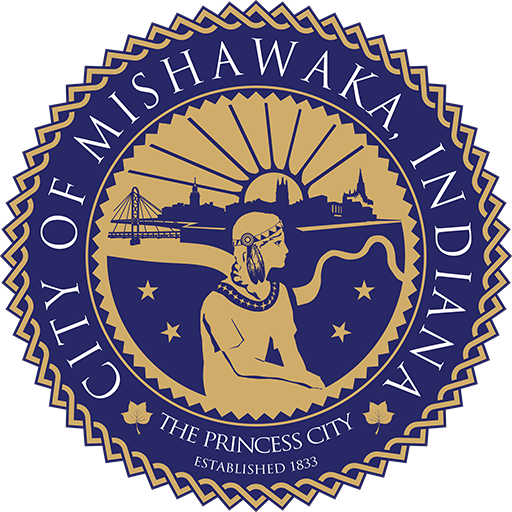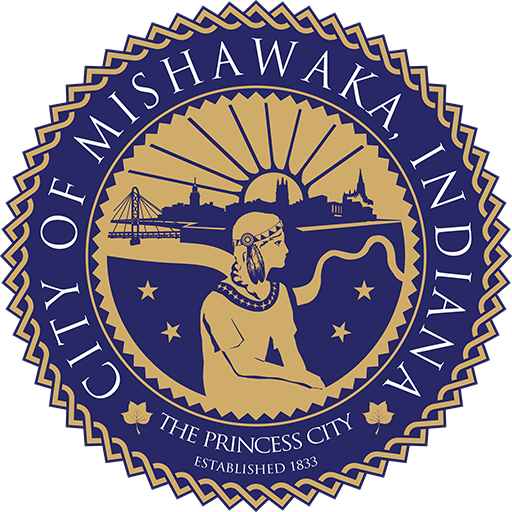Mishawaka History Timeline

1679
Frenchman Rene-Robert Cavelier, Sieur de La Salle becomes the first white man to explore what later became Mishawaka as he traveled up the St. Joseph River.
1832
1833
Alanson Hurd purchases the 640 acres that are today central Mishawaka and constructs an iron works and other buildings. The village of St. Joseph Iron Works is platted to the south.
1834
St. Joseph Iron Works begins producing pig iron, making the settlement a significant center of heavy industry. The First Presbyterian Church becomes the first religious congregation established in the village.
1835
St. Joseph Iron Works becomes the first incorporated village in St. Joseph County.
1838
The Indiana State Legislature consolidates four adjacent settlements of St. Joseph Iron Works, Indiana City, Barbee Town, and Fowler’s Addition into one municipality called “Mishawaka,” a term derived from the Potawatomi Indians’ language.
1845
The Mishawaka Academic and Normal Institute, a two-story schoolhouse, is constructed at the intersection of South Main and Fourth Streets.
1848
Church of the Holy Angels, the first Roman Catholic church building in Mishawaka, opens on Elm Street.
1851
The Michigan Southern & Northern Indiana Railway brings the first railroad service to Mishawaka. The next year, the line is extended to Chicago.
1855
The Mishawaka Enterprise newspaper begins publishing. It would later become the oldest business in the city.
1859
The Springbrook Ravine trainwreck occurs west of Mishawaka, killing 39 persons and injuring 42 more.
1861
Mishawaka men volunteer for service in the Civil War as members of Company I, 9th Indiana Infantry Regiment. After their three-month enlistments are up, a new Company I forms with three-year enlistments. James Houghton is elected captain.
1862
James Houghton, Daniel Ungry, and Jesse Miller become the first three Mishawaka men to die in combat in any of the nation’s wars when they are fatally wounded in a charge against a Confederate artillery battery at the Battle of Shiloh on April 7.
1863
Mishawaka soldiers in the 9th and 87th Indiana Infantry Regiments fight at the Battle of Chickamauga.
1864
Mishawaka soldiers in the 9th, 48th, and 87th Indiana Infantry Regiments participate in General William T. Sherman’s Atlanta campaign.
1869
The town replaces the Mishawaka Institute with a new “Union School” at First and Hill Streets. The school includes both elementary and high school classrooms. Schools on both sides of the river are unified under one superintendent.
1872
A massive fire destroys 49 buildings on parts of three blocks in the central business district but without fatalities. Days later, the town passes an ordinance prohibiting wood frame buildings in the downtown.
1874
Milburn Wagon Company leaves Mishawaka for Toledo; Mishawaka Woolen Company is incorporated.
1878
Wallace Dodge opens a sawmill and factory that begin the Dodge Manufacturing Company, which later produces power transmission equipment. Mishawaka High School’s first graduating class consist of Belle Milburn and Allie VandenBosch.
1880
Telephone service first comes to Mishawaka. Anna and Robbins Battell deed the land that becomes Battell Park to the city. Dick & Kamm Brewery becomes Kamm & Schellinger Brewery, operated by brothers-in-law Adolph Kamm and Nicholas Schellinger.
1882
St. Joseph County Orphans Home opens on West Second Street.
1884
Soldiers’ Monument honoring Civil War soldiers and sailors from Mishawaka and Penn Township is dedicated during the Fifth Annual Reunion of the Soldiers and Sailors of Northern Indiana, held in Battell Park.
1885
Streetcar line using horse-drawn vehicles begins operating between Mishawaka and South Bend.
1887
Medora Powell becomes the first black graduate of Mishawaka High School.
1889
Mishawaka Building & Loan Association is founded. It later becomes Mishawaka’s oldest financial institution.
1890
Horse-drawn streetcars are replaced by electric streetcars in Mishawaka and South Bend.
1891
A municipal water works building is completed on North Church Street; the town offices are on the second floor.
1893
Mishawaka businesses participate in the World’s Columbian Exposition in Chicago, and hundreds of Mishawakans visit the fair. St. Joseph Catholic parish dedicates its new Gothic church.
1899
Mishawaka voters decide to change their government from a town to a city. Manuel Fisher is elected the city’s first mayor.
1903
Hen Island Dam begins electricity production in the Twin Branch neighborhood and is the main power source for Mishawaka and surrounding cities.
1904
A new City Hall is built at First and Church Streets.
1905
Mishawaka annexes 1,353 acres of property into the city limits, known as the “Great Annexation.”
1908
Vice President Charles Fairbanks visits Mishawaka for a campaign rally and parade before the general election.
1909
Mishawaka hosts a Historical Pageant and Fourth of July Celebration that includes a massive parade, dedication of the Hotel Mishawaka, and turning on the city’s new electric streetlight system.
1910
Mishawaka’s population reaches 11,886 in the U.S. Census, more than double the 1900 population. A new Mishawaka High School opens at North Hill and West Second Streets. St. Joseph Hospital opens at South Spring and West Fourth Streets.
1911
The First Presbyterian Church’s new building opens at Union and East Second Streets. Simplex Motor Car Company enters two of its cars in the inaugural Indianapolis 500.
1912
The Methodist Episcopal Church opens its new building at East Third and South Church Streets. It was a gift from the Eberhart children in memory of their parents, Adolphus and Sarah Eberhart.
1916
The Mishawaka Public Library opens its new building at North Hill and First Streets. Much of the construction cost is paid for by Andrew Carnegie.
1917
Mishawaka recruits volunteer for military service in World War I. Before the war concludes the next year, more than a thousand Mishawakans will serve.
1918
An addition is made onto St. Joseph Hospital.
1924
A new Mishawaka High School building opens on Lincolnway East. Described as an “architectural masterpiece,” the building features an auditorium, gym, dining hall, and industrial arts classrooms.
1925
First National Bank opens its new office at Main and Lincolnway. Mishawaka’s movie palace, the Tivoli Theater, opens on North Main Street with seating capacity for an audience of 1,400. The Twin Branch Power Plant, a coal-fired facility next to the dam, begins operation and makes Mishawaka the regional supplier of electricity.
1926
American Foundry Equipment Company moves to Mishawaka, bringing its corporate offices from New York and its manufacturing operations from Chicago. The plant occupies the former Simplex buildings on South Byrkit Street.
1927
St. Monica Church opens its new building at Ann Street and West Mishawaka Avenue. Seating 800, it is the city’s largest church.
1930
Mishawaka’s population nearly doubles to 28,630 by the 1930 U.S. Census.
1932
Mishawaka celebrates its one-hundredth anniversary with Centennial Week, which includes a parade, historical pageant, and other events.
1937
Brothers Andrew and Herman Muldoon begin Bonnie Doon Ice Cream Company.
1939
Mishawaka schools partner with the federal Works Progress Administration to complete a concrete football stadium for Mishawaka High. It seats 8,000 fans.
1942
Mishawaka Rubber & Woolen Company produces specially-made fuel cells for B-25 bombers used in the Doolittle Raid on Tokyo and other Japanese cities.
1947
1948
St. Joseph Hospital opens another addition to its facility on West Fourth Street.
1951
Production ceases at Kamm & Schellinger Brewery.
1952
The City of Mishawaka opens its new Wastewater Treatment Plant on Lincolnway West on land that was formerly part of Lincoln Park.
1958
The Talos surface-to-air missile, manufactured by Bendix on South Beiger Street, is first installed on U.S.S. Galveston. LaSalle School Conservation District urban renewal project begins in Hooligan Heights, impacting hundreds of homes.
1960
Town & Country Shopping Center opens at McKinley Avenue and Hickory Road. First homes are completed in the Reverewood subdivision near Elm and Harrison Roads.
1963
Margaret Prickett defeats incumbent Joseph Canfield to become Mishawaka’s first woman mayor.
1964
Marian High School opens at Logan Street and Dragoon Trail.
1967
Capt. Richard Brenneman is shot down over North Vietnam and begins 1,954 days as a prisoner of war.
1968
Sen. Robert Kennedy makes a campaign appearance in downtown Mishawaka and speaks to several thousand people. Hotel Mishawaka is demolished to make way for a new U.S. Post Office. Mix Mansion is demolished. Merrifield Park Pool Complex opens.
1969
The new Mishawaka Public Library building opens at South Church Street and Lincolnway East.
1972
Mishawaka and Shiojiri, Japan, formally establish a sister city relationship.
1973
John Young Junior High opens on North Main Street, replacing Main Junior High.
1974
Demolition of the Northwest Block buildings begins and continues in 1975 and 1977-78. Mishawaka Police Department moves from City Hall to the former U.S. Post Office building on South Church Street.
1975
Beiger Mansion is badly damaged in a fire, requiring years of restoration.
1977
City of Mishawaka begins Emergency Medical Services Department under Chief Michael Hargreaves.
1979
University Park Mall, a 964,051 sq. ft. indoor shopping center, opens on Grape Road.
1980
The Twin Branch Power Plant is retired after 55 years of electricity generation.
1981
The Church-Union underpass opens, facilitating traffic flow between downtown and the area south of the Conrail tracks.
1983
Mishawaka celebrates its sesquicentennial with numerous events throughout the year, including a Princess Mishawaka contest and A Day in the Park celebration in Merrifield Park.
1984
The Mishawaka-Penn Public Library opens its Bittersweet Branch. Production of the military Humvee vehicle begins at AM General’s plant northeast of Mishawaka.
1985
Liberty Mutual opens its 93,000 sq. ft. Midwest underwriting office at North Main Street and Lincolnway West.
1986
City Hall moves from First Street to the former Bingham School on East Third Street.
1988
Construction of Edison Lakes Corporate Park begins near Day Road and North Main Street.
1995
Five hotels open on Mishawaka’s north side. Mishawaka Police Department opens its new police station at Church and First Streets.
1997
Uniroyal ceases production at its downtown Mishawaka plant.
1998
Mishawaka-Penn Public Library opens its expanded and renovated downtown building, which includes the former U.S. Post Office as the Heritage Center.
1999
School City of Mishawaka closes Beiger Junior High, Mary Phillips School, and North Side School, opens Liberty School, and moves all junior high students into an expanded John Young Junior High.
2000
Demolition of the former Uniroyal buildings is completed by imploding the five remaining buildings and the 250-foot-tall smokestack as thousands watch.
2004
Robert C. Beutter Riverfront Park opens on land that was formerly the Uniroyal complex.
2006
President George W. Bush speaks at Bethel College, becoming the first President of the United States to visit Mishawaka. The foundry closes at the former Dodge plant, marking the end of 125 years of manufacturing at the site. The Capital Avenue Expressway is open from Indiana 23 to Lincolnway East.
2008
Schurz Communication offices and the WSBT studios leave South Bend and relocate to Douglas Road in Mishawaka.
2009
The final phase of the west Riverwalk is completed, forming a loop between the Logan Street and Main Street Bridges and parks on both the north and south sides of the river. St. Joseph Regional Medical Center opens its $355 million complex on Douglas Road.
2010
The Diocese of Fort Wayne-South Bend consolidates St. Monica, St. Joseph, and St. Bavo schools into one Mishawaka Catholic School with three campuses.
2013
The Capital Avenue Expressway and railroad underpass are open from Lincolnway East to the St. Joseph Valley Parkway.
2015
New equipment and structures transform Central Park into one of the city’s most popular recreational sites.
2017
The St. Joseph County V.A. Clinic opens on Trinity Place, east of St. Joseph Regional Medical Center.
2019
The Mill at Ironworks Plaza opens, bringing 232 high-end apartment units to the Mishawaka riverfront. Liberty Mutual announces it will vacate its downtown Mishawaka office building.
2020
Mishawaka reaches a demographic milestone in the 2020 U.S. Census: 51,063 residents.
2022
City Hall relocates from East Third Street to the former Liberty Mutual building, bringing municipal offices, utilities, and police under one roof. Beutter Park’s events center and ice-skating ribbon open.

